Message Thread:
When should I use the log dogs?
12/31/15

I am learning and would like advice on when to use the log dogs. Clearly when the log is still round . .. I follow the advice of Pr Wengert and remove the jacket and flitches, then flip the log 180 degree and do the same on the other side. For that second set of cuts, the log feels very stable on the bed, held by just gravity and the small square 3/4" fence (LT15). Then I turn the log 90 degrees and hold it between the fence and the log dogs. Same removing of jacket and flitches. Then I rotate 180 degrees to make the cant. If the 3 sided cut log at that point is wider then tall, it feels stable, and I wonder if the log dogs are needed?
Then either I flat saw it or quarter saw, and the closer to the bed, the less inclined I am to use the dogs: 1) I always worry that I will forget them as they are on "the other side of the log" from where I stand; 2) the lower the blade the least momentum to flip the can't (I guess..). I tend to just use the 3/4" fence, not the log rests, also for fear of cutting into them :(
Should I use the dogs for all cuts in which they are below the blade, or it is ok to "guestimate" when the log is stable?
A secondary questions is can I cut 2 quarters at the same time (flipping them 90 degrees between each cut), or is this an unstable situation? It would reduce the need to load and unload quarters.
Thanks for advice and Happy New Year!
1/1/16 #2: When should I use the log dogs? ...

Log dogs are used virtually 100% of the time when sawing a log into lumber on the headrig. The dogs provide safety from catastrophic log or cant movement, plus they provide stability so that the limber thickness is uniform.
A commercial carriage often has a safety feature built in so that you cannot cut the dogs.
Often the dogs have two different extension distances...they protrude more when you first start, but then can be retracted so they stick out less than 1" when getting close to the end.
The dogs do need to be sharpened so they penetrate easily into the wood.
1/1/16 #4: When should I use the log dogs? ...

So for sure on big machines, but also on small bandsaw? This is a WM LT15.
1/1/16 #5: When should I use the log dogs? ...
 Website: http://steadwood.djfirefly.com
Website: http://steadwood.djfirefly.com
I used the dogs on every cut. Here's why...
The band always pulls the cant in the direction of blade movement. At higher feed speeds, if the dogs are not secured, there is a chance the cant will roll over while the blade is pulling so hard.
It ruins both the board being cut, as well as the next board or two in the cant. If the cant rolls this way, you'll also likely wreck the blade, or get it stuck in the cant, at the very least, forcing you to shut down and extract the blade. You might even lose the blade if you are feeding fast.
Also, I always secure both dogs, so that the log holds fast to the posts, and doesn't "pivot" around one of the dogs as the blade moves through.
Once in a while, when I cut short logs, I cant clamp both dogs, and I always notice how the cant moves around during the cut.
So use them, use both of them, be safe, and you'll be cutting for many more years to come...
1/4/16 #6: When should I use the log dogs? ...
 Website: http://www.norwoodsawmills.com
Website: http://www.norwoodsawmills.com
The log dog question has been well answered, but I'm not sure I understand your second question about cutting two quarters at the same time. Bottom line is, how stable is the cant? If you can move it by hand with a hard shove, don't try to saw it. Think about the forces of the blade against the wood. It is trying to slide the log and rotate it at the same time. It took several bent blades from a moving log before I got it into my head that the blade does try to move the log. No, it is not as serious or damaging as a circle saw, but don't take chances.
1/4/16 #7: When should I use the log dogs? ...

Ah... Dave's question about your cutting 2 quarters question made me realize what you are asking.
I'm betting that you are quarter / rift sawing larger logs to try and maximize q-sawn yield, right? You split the log down the pith, and then quarter it again, to get a set of 4 - 90° quarters. Then you place one of the quarter's faces down, cut a board off the bottom, and perhaps rotate it again 90°, and cut one off of that -- back and forth until your "quarter cant" won't produce a board anymore. Do I have that roughly correct? I have done this before, and it fits with what you are saying...
Anyway, I think you will be able to cut through 2 quarters this way, but you may need to find a better way to hold them. The weight of the log itself on top will certainly help to hold them in place. And when you enter a cant near the bottom (as you would need to to q-saw this way), the blade forces will be exerted near the bottom of the cant. This will try to slide the whole cant in the direction of the blade, but will be resisted by the friction forces that are being generated by the pull of gravity on the cant that creates a friction force that resists movement in the opposite direction of the blade. This will generally hold the cant in place, until the weight of the cant is reduced to the point where it won't anymore, at which point you can clamp them, or just throw away the rest.
On my Timber Harvester mill, there are little "tabs" on the ends of the bunks that are there to snug up to the square edge cant when I tighten up the dogs. Those help to both secure the cant in place and keep it between the saw guides, and also to keep the cant from rolling over when sawed. I guess your mill has those too, right?
When I do this type of sawing, I find that I need to flip the (sometimes heavy) cant back and forth so that I can pull out the boards, and get myself consistent thicknesses. But I run out of space to do that, if the cant is more than about ~14" wide.
I don't think I would be able to flip 2 quarter cants out of the way enough to be able to pull out both boards. I'd have to do one at a time, and maybe even move to the opposite side of the mill in order to get sufficient leverage on it. On balance I think it would take more time, not less time, than sawing them separately. And I think that's the essence of what you are asking, right? If so, then that's my answer ;-)
1/4/16 #8: When should I use the log dogs? ...
 Website: http://www.norwoodsawmills.com
Website: http://www.norwoodsawmills.com
Advice on using (or not using) clamps is a little like advising whether to use seat belts. Few people would want to take the responsibility of saying "don't bother". Truth be known, if the cant has a flat side down and weighs more than a couple hundred pounds, I save a few seconds by skipping the clamping process. The cant sliding sideways isn't a huge deal, but turning or sliding off the crossbunks can be a PITA. As Eric says, there are tabs on most band mills that hold the cant from sliding off-- as long as there is a square corner for them to catch. The bottom line is, if there is any concern about personal safety, DON'T DO IT. Keep any helpers on the safe side of the mill (opposite the sawdust chute), and away from where the log would land if it should decide to roll off the track.
If you do a Youtube search for "How to Quarter Saw a Log", you'll get some good ideas. Here is one such...
Video on quartersawing
1/5/16 #9: When should I use the log dogs? ...

Thanks for the honest answers :) I like Dave's comparison with the seat belt: quite appropriate.
In Fig 1, there is no doubt, the log dogs are needed:
In the Fig with the cant, I also suspect they are needed:
It is really in the 3rd Fig, that I worry. The force applied by the blade has the same horizontal component, but the vertical component is less.
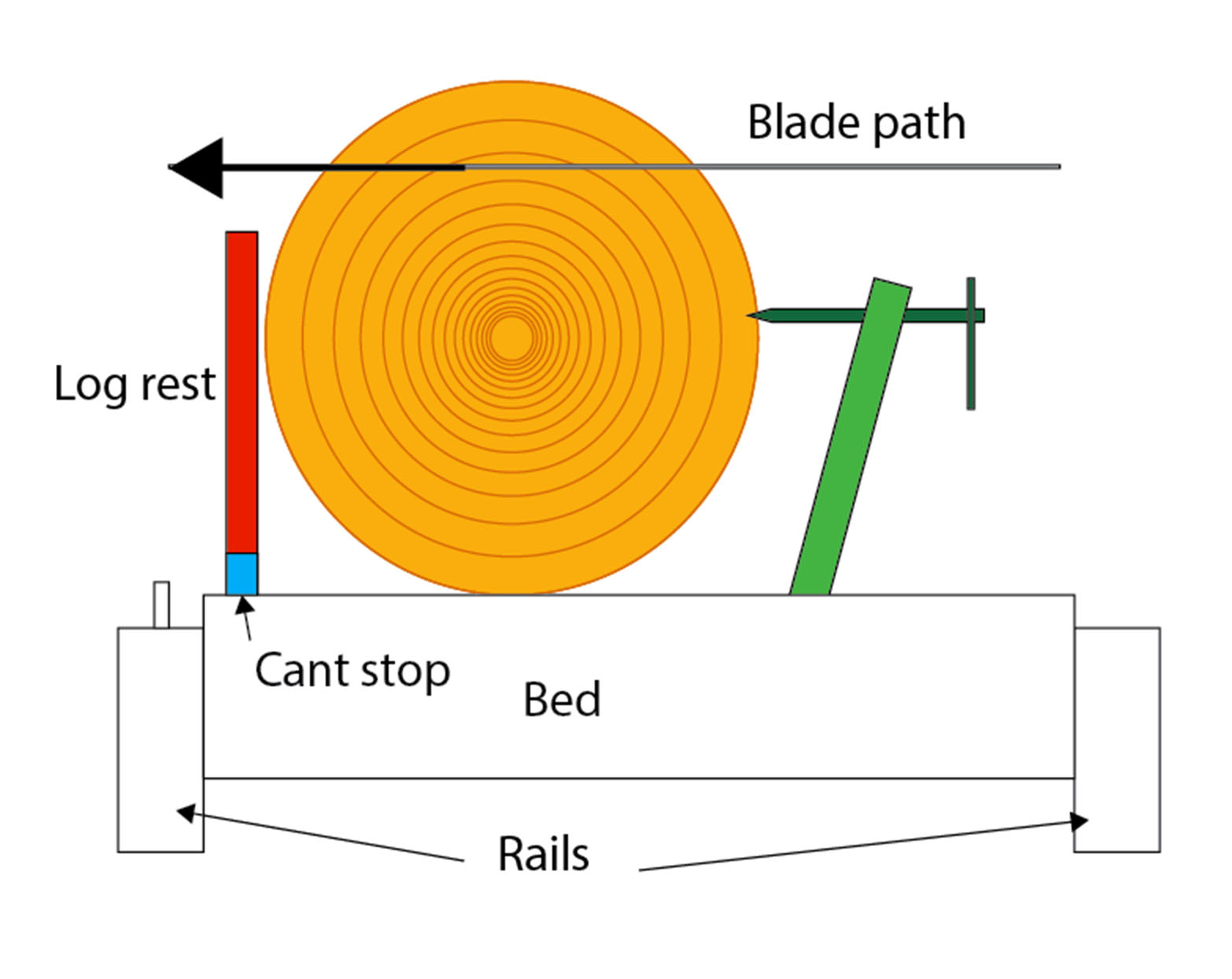
View higher quality, full size image (1566 X 1244)
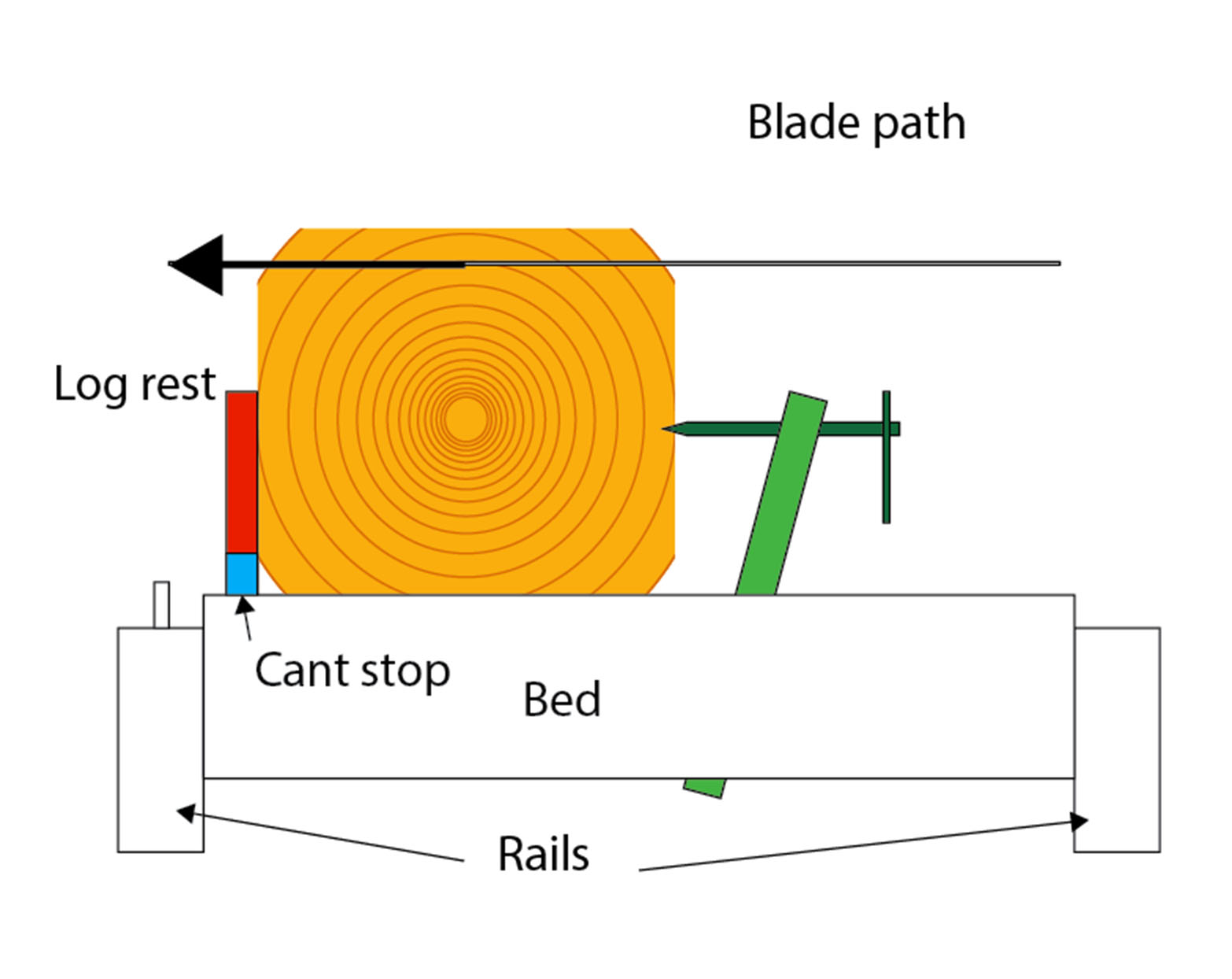
View higher quality, full size image (1566 X 1244)
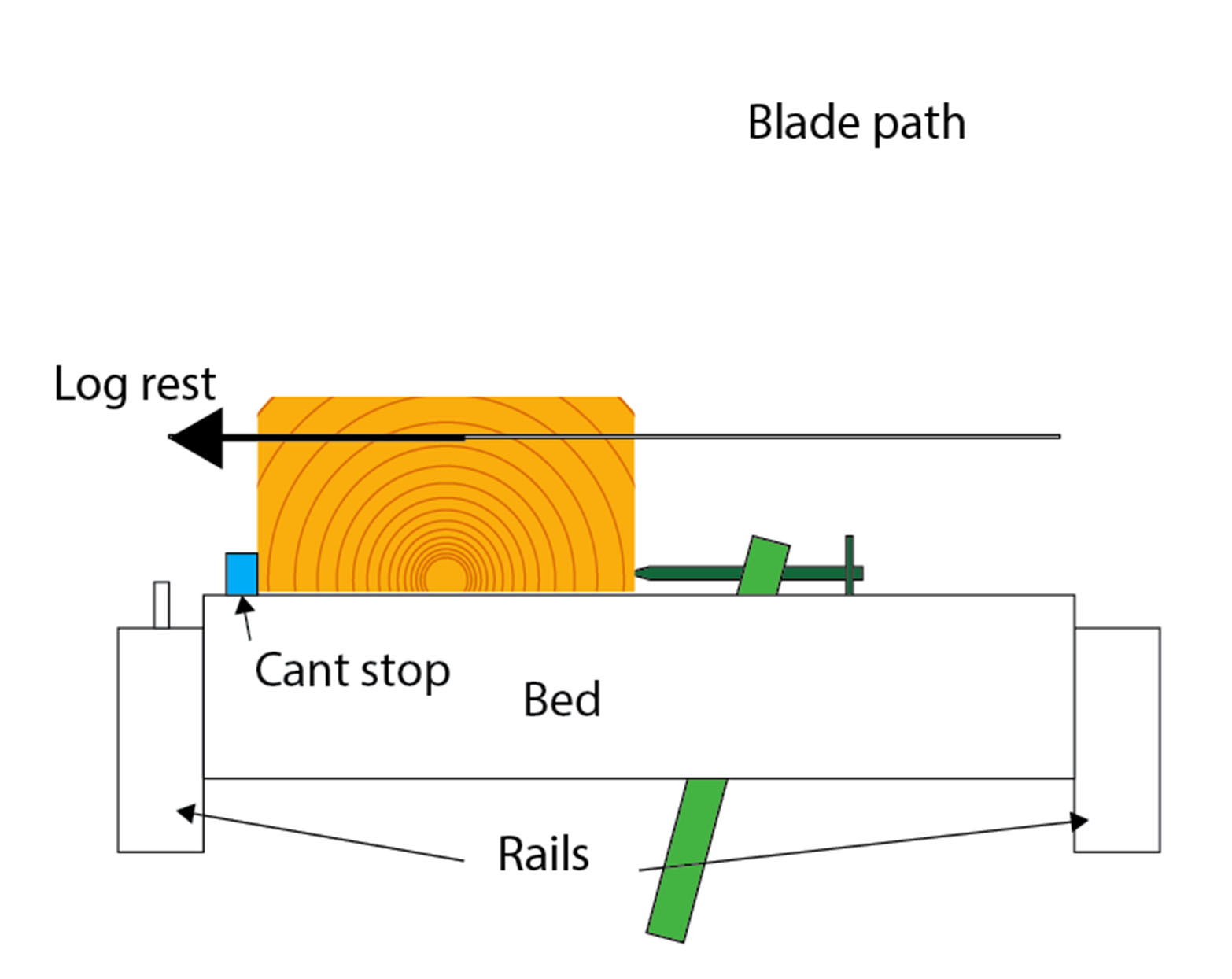
View higher quality, full size image (1566 X 1244)
1/5/16 #10: When should I use the log dogs? ...

More clarifications for the second question. Yes I saw the video that Dave showed (the Norwood guy).But he balances the 1/4 log on a thin edge and has to make sure the top surface is horizontal. To me that looks like a lot of complications (Fig 1).
I had done what is on Fig 2: cut the lower board of the 1/4 log, then remove that board, turn the left over 90 degree and again cut the lower board.. and so on until the left over becomes firewood.
I was wondering about putting two 1/4 side by side as in Fig 3. then doing the board removal, left over flipping and so one. Of course, the log rest is hard to place in this condition... that was what prompted my first question....
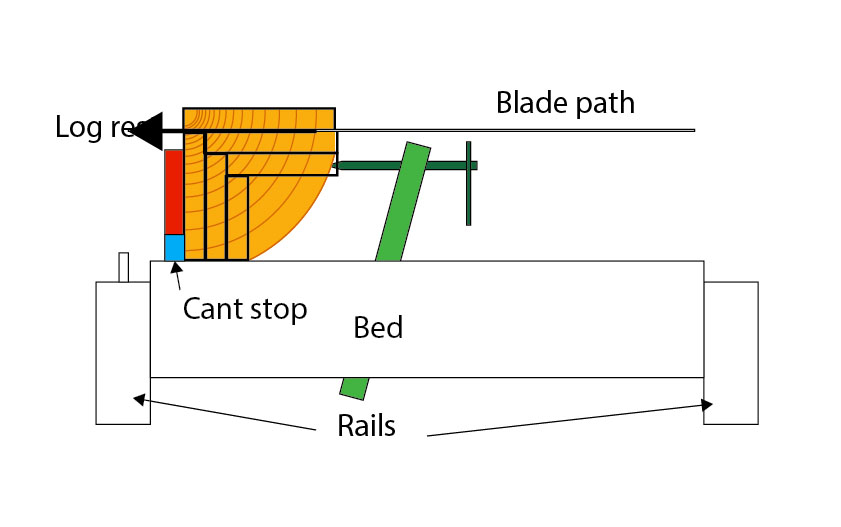
View higher quality, full size image (841 X 527)
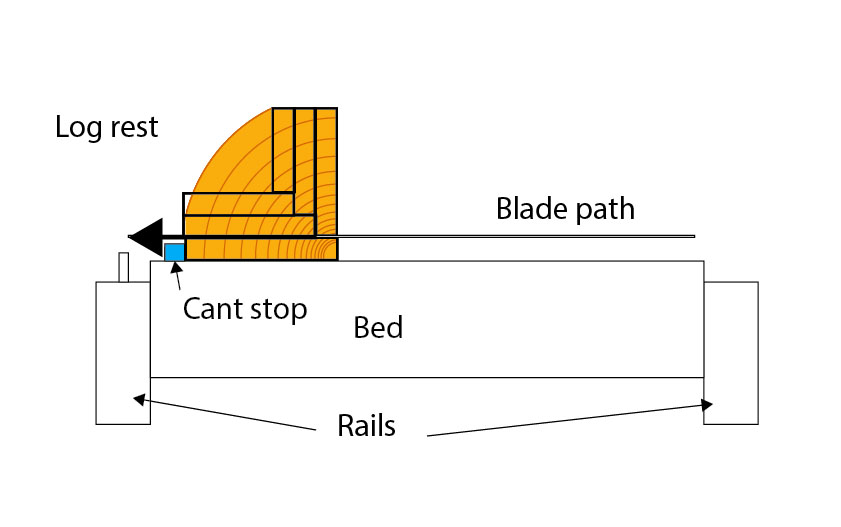
View higher quality, full size image (841 X 527)
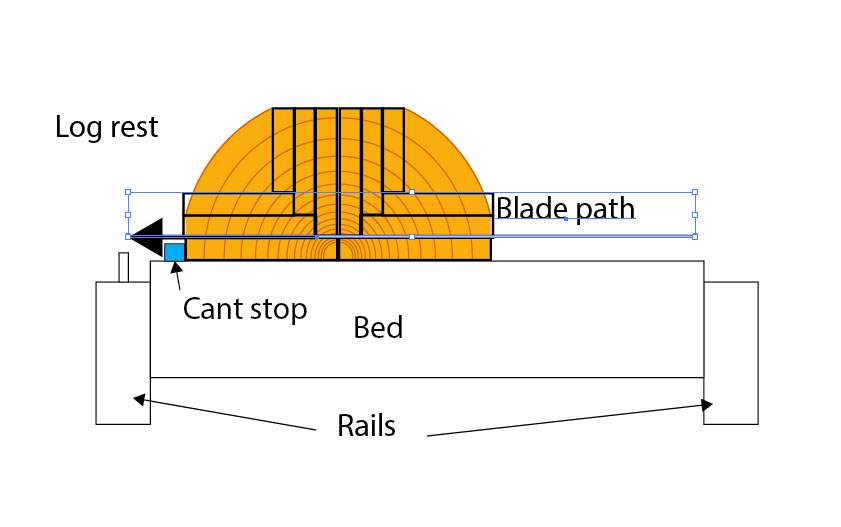
View higher quality, full size image (841 X 527)
1/7/16 #11: When should I use the log dogs? ...
 Website: http://www.norwoodsawmills.com
Website: http://www.norwoodsawmills.com
Philippe, nice drawings! It really helps picture what you are trying to do. As far as the cant goes (top set of illustrations), as long as the blade is pulling the cant against the stops, you are probably ok, because of the weight. When you get down to the last couple of cuts, you don't have the weight, and the cant is more likely to flip up. A good test is to try to turn the cant with a cant hook. As long as it resists turning and the log stops are up against the flat side so it can't slide over them, you are probably ok.
I don't see a problem with quarter sawing the cants 2-up, as in your last illustration, especially with the weight of the wood on top-- but again, the last 3 or 4 cuts will need clamps.
Sawmilling is full of those "geez, what was I thinking" moments. I've destroyed a half-dozen blades, had logs roll off the mill, and sawn into log stops. It is all part of the learning experience which, in my case has also included two dislocations, several lost fingernails, and numerous bruises.
Different mills may allow or require different techniques. I've tried quartersawing off the bottom, and working from the top works better for me. Others, even with the same model mill prefer to work off the bottom. As long as it doesn't put anyone in a dangerous position or defeat any safety devices, you can chock up mistakes to learning.
|